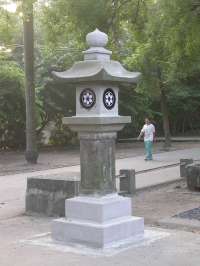'KEIDAI reappearance' project, July to September 2005, is reappearance of one of a Japanese shrine precincts in Ciaotou, south of Kaohsiung, Taiwan.
Most Japanese Shinto shrines in Taiwan were destroyed by Chiang Kai-shek's Kuomintang after W.W.Ⅱ and relics of shrine lie scattered here and there.
Even the Ciaoto shrine was destroyed in the same way and its relics lie scattered around 2 km all sides. Some relics are under the ground and some relics are half under the groung. To my surprise, when I was thinking its project with the coffee shop's outside table, I've noticed that the table itself was one part of Japanese shrine-relic. Through my thoroughly 'land' research and many interviews with locla people, I could list them up and made a plan for 'KEIDAI reappearance' project. And then I've applied to Kaohsiung goverment for its support.
From the beginning of this project, there were so many approval and disapproval opinions by local media-TV and newspaper- and local people. The 'approval' signature-collecting campaign by ToSan generation (@1) in Ciaotou and my project explanation meeting for local people (@2) made Kaohsiung government understand its project without yielding any emotional and disapproval opinions with threat.
After all, Kaohsiung government supported it as an art-sculpture-work, not a cultural heritage of Japanese rule days. One Japanese stone-lantern, Chouzuya/Stone water tub(@3) and the Ciaotou shrine's name pole were re-installed on the original places (@4) on the memorial day of original Ciaotou shrine's establishment day. Japanese stone-lantern consists of 7 stone parts. I could find and collect 4 stone parts and 3 missing parts was made by Taiwanese sculptor along my research data about Japanese stone lantern in those day's design and size .
And now the big explanation board was made there and they are teaching materials for Ciaotou's land history.
@1 people who grew in Japanese rule days and have tend to a positive opinion about its days. @2 7th, Sep,2005, supported by Sugar Field Factory which run Kio-A-Thau Residence program. @3 It's for hand-washing
'KEIDAI reappearance' project, July to September 2005, is reappearance of one of a Japanese shrine precincts in Ciaotou, south of Kaohsiung, Taiwan.
Most Japanese Shinto shrines in Taiwan were destroyed by Chiang Kai-shek's Kuomintang after W.W.Ⅱ and relics of shrine lie scattered here and there.
Even the Ciaoto shrine was destroyed in the same way and its relics lie scattered around 2 km all sides. Some relics are under the ground and some relics are half under the groung. To my surprise, when I was thinking its project with the coffee shop's outside table, I've noticed that the table itself was one part of Japanese shrine-relic. Through my thoroughly 'land' research and many interviews with locla people, I could list them up and made a plan for 'KEIDAI reappearance' project. And then I've applied to Kaohsiung goverment for its support.
From the beginning of this project, there were so many approval and disapproval opinions by local media-TV and newspaper- and local people. The 'approval' signature-collecting campaign by ToSan generation (@1) in Ciaotou and my project explanation meeting for local people (@2) made Kaohsiung government understand its project without yielding any emotional and disapproval opinions with threat.
After all, Kaohsiung government supported it as an art-sculpture-work, not a cultural heritage of Japanese rule days. One Japanese stone-lantern, Chouzuya/Stone water tub(@3) and the Ciaotou shrine's name pole were re-installed on the original places (@4) on the memorial day of original Ciaotou shrine's establishment day. Japanese stone-lantern consists of 7 stone parts. I could find and collect 4 stone parts and 3 missing parts was made by Taiwanese sculptor along my research data about Japanese stone lantern in those day's design and size .
And now the big explanation board was made there and they are teaching materials for Ciaotou's land history.
@1 people who grew in Japanese rule days and have tend to a positive opinion about its days. @2 7th, Sep,2005, supported by Sugar Field Factory which run Kio-A-Thau Residence program. @3 It's for hand-washing

